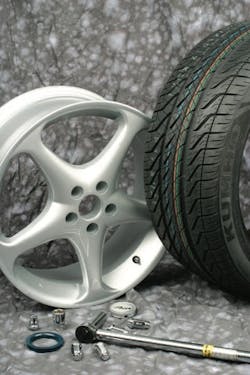Wheel fasteners are arguably the most important components on any vehicle, responsible for securing the wheels to the vehicle, yet are often the least understood and appreciated. This brief article offers a basic overview of the often overlooked threaded wheel fastener — how to identify it and how to handle it.
This includes information dealing with fastener thread size, seat styles and torque values. Our goal is to provide clear and accurate explanations of various wheel fastening systems that will help installers select the correct type of fastener for a given application.
NOTE: The common method of attaching a wheel to a hub involves a group of individual threaded wheel fasteners (wheel nuts or wheel bolts), involving a pattern of four, five, six or eight fasteners per wheel. Another type of wheel clamping system involves attaching the wheel to the hub with a single spindle nut. This is most commonly referred to as a knock-off or pin-drive system.
Wheel fastener seat styles
Identifying and matching fastener seat styles is absolutely critical. The “seat” refers to the contact area between the base of the fastener head and the wheel’s fastener pocket. Although variations exist, three basic seat styles are in common use today. These include conical, radius and flat-seat types.
Conical wheel nuts (or wheel bolts) feature a straight taper at the seat area. Conical fasteners are also called “tapered” or “cone” types. All three names refer to the same style. This type of taper is created most commonly in a 60-degree angle.
Radius seats are also called “ball” or “rounded” seats. As the name implies, the seat features a radiused “ball” shape that nestles into a ball-shaped pocket in the wheel. Many European vehicles such as Porsche and Mercedes use radius seat styles, in either nut or bolt applications.
The flat seat style is most often called a “mag” style (the term “mag” doesn’t imply anything in terms of geometric shape, it’s simply a slang carryover from the early days of the American performance scene when race wheels were cast magnesium, and commonly used a flat seat because it was easier and cheaper to produce a round hole in a flat hub center area.
As we all know, the unfortunate misnomer “mag” has stuck with us as a catch-call to denote any custom wheel, whether it’s made of magnesium, aluminum or other alloys). Mag style (flat seat) nuts generally feature a smooth shank extension under the head, used to center the wheel and to provide needed thread engagement depth.
Never mix seat styles! If a wheel is designed for conical 60-degree seats, the only fastener seat style that can be used is a 60-degree conical type. The same rule applies for radius and flat seat styles. Only use the correct seat style of fastener for the seat style of the given wheel. Using the incorrect seat style can, and likely will, result in fastener loosening, wheel damage, and potential tragedy due to loss of vehicle control when the wheel wobbles or separates from the vehicle. It’s simply impossible to overemphasize this point. The wheel fasteners are the only connection between the vehicle and the wheels. Without proper fastening, you’re flirting with disaster.
The three most important elements of wheel fastening are:
- Proper seat style for the wheel.
- Correct thread size (diameter, pitch, length).
- Proper clamping (torque) value.
[PAGEBREAK]
Thread engagement
Aside from selecting the proper seat style for the wheels at hand, another consideration is thread engagement. In other words, how far the nut travels over the stud, or how far the wheel bolt travels inside the hub’s threaded hole.
The rule of thumb whenever discussing threaded fastener engagement is to achieve a minimum engagement length that is equal to the diameter of the fastener’s threads. For instance, if the stud or bolt shank is 1/2 inch in diameter, the nut (or bolt) must engage its threads by at least 1/2 inch. This provides the minimal theoretical engagement for proper clamping load. However, the industry usually takes advantage of greater thread engagement depth, for added safety (the deeper the threads engage, the longer it takes to actually loosen the fastener; and in some cases, longer studs are used simply to aid in wheel installation onto the hub).
Thread size
Thread sizing is not difficult to understand. The problem is that most people won’t take the time to learn this very basic theory. Whether inch or metric, we need to know the diameter, the thread pitch and the thread length. For example, when dealing in an inch format, a nut identified as a 1/2 x 20 x 1 indicates that the thread diameter (the diameter of the stud it will accept) is 1/2-inch. The number “20” indicates thread pitch. That refers to the number of threads that exist per inch of length. In this case, the thread count, or “pitch” is 20 threads-per-inch. The final number refers to the length of the thread engagement. The number “1” means that the nut features 1 inch of internal thread engagement length.
If the fastener is metric, diameter is represented in millimeters, pitch represents the distance from one thread to the next thread, and thread or shank length is represented in millimeters. For example, a 14 x 1.5 x 70 wheel bolt would indicate a 14 mm diameter, a 1.5 thread pitch and a thread or shank length of 70 mm.
In terms of thread pitch, it’s really very simple: With inch-format, the larger the number, the “finer” the threads (20 threads per inch would mean more threads within a given area than, say, 16 threads per inch). If the format is metric, the larger the number, the more “coarse” the threads would be (a distance of 1mm between threads would result in a greater number of threads in the same area as, say a distance of 1.75 mm between threads). So, in inch format, smaller pitch numbers mean “coarse” threads, while larger numbers indicate “finer” threads. In metric format, small numbers indicate finer threads, while larger numbers indicate more “coarse” thread. Many people tend to make this issue more confusing than it really is. Simply think about what the number means (number of threads per inch if the fastener is inch-type; or distance between threads, if the fastener is metric type).
If we were referring to a bolt, both diameter and pitch are determined the same way. Length would then refer to the shank length (the length of the bolt under the head), or in the case of wheel bolts, the length of the bolt from the bottom of the seat to the tip of the threaded end.
In order to accurately identify the thread diameter, pitch and length of any wheel fastener, you can handle this by obtaining a total of three readily-available tools: a combination bolt/nut sizing card (these are hard plastic and are available to cover both inch and metric sizes) and two thread pitch gauges (one inch and one metric). That’s all you need to quickly and accurately read any wheel bolt or nut without any guesswork.
Common wheel fastener thread sizes:
7/16-20
1/2-20
9/16-18
M12 X 1.25
M12 X 1.5
M12 X 1.75
M14 X 1.5
M14 X 2.0
Head/drive styles
The “head” of a wheel bolt or nut features a specific drive design and appearance approach. The most conventional drive style involves a hex (six-sided) that requires the use of a six-point wrench. However, other styles do exist, although not encountered as often. These include female hex drive “tuner” nuts which feature a relatively small and smooth outer body diameter (to fit into small-diameter fastener recesses in some wheels), and a female hex drive hole, requiring a male hex bit for service. Yet another drive style is the spline-drive head which features a symmetric pattern of straight-cut external splines instead of hex walls. Splined fasteners require a dedicated female spline socket, available from the maker of the splined fasteners.
In terms of appearance, nuts may be either open (the threaded hole runs all the way through the nut) or closed (threads terminate inside the nut). Closed head styles are varied, and include flush tops, raised conical domes, raised flat-top domes, extended hex walls (for easier reach and handling and greater wrench contact area) and radiused domes.
[PAGEBREAK]
Body and thread length
All of the wheel nut and wheel bolt styles that we’ve mentioned are available in a wide variety of lengths, in terms of drive area or thread engagement area. Drive area height may be dictated by the thickness of the wheel’s center hub, or by the design of the wheel (maybe the nut or bolt head needs to project out farther for easier wrench access). The necessary thread engagement area will affect length as well, involving either inboard thread reach or outboard projection based on stud length. Thread length/depth is extremely critical. The nut-to-stud or bolt-to-female thread engagement area must be sufficient to properly secure the wheel.
At bare minimum, thread engagement depth must be greater than the diameter of the thread (for example, if the thread is 12 mm, thread engagement depth must be greater than 12 mm). Pay particular attention with closed-design nuts. Make sure that the stud does not bottom-out inside the nut. This will prevent the fastener from seating onto the wheel. By the same token, if a wheel bolt’s shank length is too long, this will prevent full seating at the wheel.
Wheel fastener tightening
Never use an impact gun to remove or install threaded fasteners when dealing with custom alloy wheels.
The reason to avoid using an impact gun during removal is simply to avoid scratching the fastener pockets of the wheel. If you insist on removal with a gun, use only a clean thinwall socket and run the gun at a slower speed. It’s easy to scratch the pockets with the socket or the exiting nut or bolt, even while trying to maintain control gun control.
Whether we’re dealing with a bargain-basement, impurity-riddled aluminum casting or the finest and strongest billet, forged or investment-cast alloy wheel, proper clamping force is critical for both wheel care and performance.
For one thing, over-tightening can gall or deform the wheel’s fastener pocket seats. Excessive over or unequal tightening can distort both the wheel center section as well as today’s commonly thin-wall hubs. This can result in a distorted brake rotor, leading to brake pedal pulsation. Considering the lightweight rotor hats featured on many of today’s vehicles, that’s an open invitation to disc brake warping and brake pedal bounce, which will surely result in a comeback complaint.
When taper or round seat wheel fasteners are tightened, an interference fit is experienced. The male seat of the fastener contacts the female seat of the wheel and creates a small wedge contact when tightened, creating a pressure point that helps to lock the fastener in place. If either type of fastener is under-tightened, they can loosen during operation. If over-tightened, the fastener can become fatigued and can deform the material in the wheel’s female seat pocket, which can result in fastener loosening. The shape of the radiused seat reduces the effect of over-tightening since contact pressure is more evenly distributed than with a taper seat style.
Flat seat style is used almost exclusively with alloy wheels, since in the early days of alloy aftermarket wheels, the alloy material may not have been strong enough to handle the frictional forces created by tapered or radiused seats.
Over-tighening a flat seat nut can deform the wheel, causing the aluminum under the washer to extrude, which displaces the aluminum, causing the nut to loosen.
Over-tightening can also stretch the wheel studs or wheel bolt shanks beyond their elastic range. All bolts or studs are designed to stretch a miniscule amount when optimal clamping load is achieved. This elasticity of the stud or bolt is what helps to secure the wheel on the hub. When torqued to specification, this is referred to as achieving the proper “clamping load.” If the stud or bolt is excessively over-tightened, it’s possible that it will stretch beyond its yield point, losing its “rubber band” effect. If stretched beyond the yield point, the stud or bolt becomes so weak that it cannot provide the clamping load needed. The result: the fastener loosens or the stud or bolt shank breaks.
Always follow the torque specifications listed by either the vehicle manufacturer or by the wheel maker. Don’t guess. Actually take the time to pick up a calibrated torque wrench and tighten all of the wheel’s fasteners, in the proper sequence, in several steps to achieve final (and equal) torque values.
While the use of torque-limiting “sticks” is common, when dealing with alloy wheels, the preferred method involves using a calibrated torque wrench. Note that in addition to dial or micrometer “click” style torque wrenches, today’s tool market includes high-precision digital torque wrenches that prove quite handy. With the press of a button, you set the desired torque value. Once that value is achieved, the tool “beeps,” vibrates and illuminates a LED light, features that are well appreciated in a noisy shop.
Never tighten wheel fasteners in a progressive adjacent pattern. Tighten in a “crisscross” pattern in order to evenly spread the clamping load to avoid warping the wheel or hub face.
[PAGEBREAK]
Retorque
Specifically when dealing with alloy wheels, it’s highly advisable to re-check the value of each fastener after about the first 50 to 100 miles of operation. Due to metal compression/elongation and thermal stresses, the clamping loads may change during initial use. When rechecking torque value, wait for the wheels to cool to ambient temperature (never torque a hot wheel). Loosen and retighten, to value, in sequence. Again, some will argue that this step is not necessary, but it’s better to be safe than sorry, and it’s better to catch a loose nut early as opposed to too late.
Wheel fastener (nut or bolt) torque values
While you should always refer to the vehicle manufacturer’s recommendations for proper wheel fastener torque values, following is a generic guideline. Don’t guess. Adhere to the vehicle maker’s specs.
Thread size Torque
(ft.-lbs.)
12 mm 75-85
14 mm 85-100
7/16 in. 70-80
1/2 in. 75-85
9/16 in. 135-145
Wheel locks
As a deterrent to would-be wheel thieves, “wheel locks” have been popular additions to vehicles equipped with expensive alloy wheels and high-dollar tires. Contrary to the term “locks,” these fasteners do not actually “lock.” Rather, they feature a drive design that requires a special wrench that matches the specific design of the fastener’s drive. Commonly, “locking” lug nuts or wheel bolts may feature an irregular female keyway machined into the fastener head, requiring a drive tool with a matching male shape. Another common approach features a splined design, requiring a matching female-splined tool. If a lock tool is missing, removal of the locking fastener may require either welding a bolt or nut to the locking fastener, a specialty gripping tool (similar to a female “easy-out” tool) or a call to the wheel lock manufacturer to order a replacement lock key.
Knock-off/pin-drive system
Many race cars (as well as a few vintage street cars such as some old Corvettes, Ferarris, AC Cobras, etc.; and some late-model exotic cars, such as Porsche’s Carerra GT) feature a wheel fastening system that involves a single large center nut instead of a series of individual fasteners.
Commonly called “knock-off” or “pin-drive” wheels, this features a large center hole in the wheel that slides over an extended male threaded spindle. A large center nut (sometimes hex sided, sometimes featuring two or three large “wings”) secures the wheel to the hub. This system is often called a “knock-off” because (in the case of winged center nuts) a large lead hammer is sometimes used to loosen or tighten the center nut (where the nut is winged). Even if the nut is hexed, a large special wrench may feature extended leverage arms that allow the use of a lead hammer to “knock” the nut. The term “pin-drive” refers to the series of short stubby dowel pins located on the hub face that engage into holes on the rear of the wheel center. Locating the wheel onto these pins prevents the wheel from rotating in relation to the hub. Basically, the term knock-off and pin-drive are synonymous.
It’s important to be aware that a knock-off wheel system may feature left-hand threads and right-hand threads on opposite sides of the vehicle. It’s critical to recognize this before attempting to loosen a left-hand thread nut by trying to rotate it counterclockwise. Some pin-drive systems feature right-hand threads on the right side of the car and left-hand threads on the left side; while some cars may feature the opposite (left-hand threads on the right side and right-hand threads on the left side).
As an example, of a later-model exotic application, the center nuts on the 2005 Porsche Carrera GT feature a spline-type engagement, requiring a special dedicated Porsche tool for service. This socket tool is part of a “torque-multiplier” Porsche tool kit. The socket engages the nut, while a special torque multiplier gearbox attaches to the socket. The Porsche torque specification for these nuts is 407 ft.-lbs. Initially that sounds like an impossibility (after all, how many folks have a 400+ ft.-lbs. torque wrench lying in their toolbox?). However, that’s where the torque multiplier comes in. Simply adjust your torque wrench to 128 ft.-lbs. and attach it to the multiplier tool. As you pull to a mere 128 ft.-lbs., the multiplier gearbox converts this amount of force into an effective 407 ft.-lbs. The tool isn’t cheap (around a cool $2,000 at your local Porsche dealer), but it makes the job easy and precise.
Naturally, since only a single large nut secures the wheel in place, you want to make certain that the nut won’t accidentally loosen. In addition to achieving the specified torque value when tightening the nut, a back-up system is often employed to maintain the nut’s position. If the nut is the wing-nut style, stainless steel safety wire can be used to insure against loosening (wire is run through a small hole in one of the wings to a small hole in a wheel spoke). In the case of the Porsche Carrera GT, the alloy nuts feature a spring-loaded tab that engages in a spindle slot.
Yet another potential example of a shop encountering pin-drive wheels is the customer who owns an AC Cobra replica. While the majority of these cars (commonly referred to as “kit” car Cobras) will feature common five-bolt hubs along with traditional wheel nuts, some examples may feature the original style pin-drive hub system, wherein the center spindle nut threads onto the spindle with a three-wing-style nut that must be loosened or tightened using a lead hammer. This vintage style then requires a means to prevent the nut from loosening. This involves installing a length of stainless steel safety wire that connects one of the nut’s “wings” to the wheel (small wire holes should exist on both the wings and the wheel.) Granted, it’s rare that you’ll encounter this, but it’s good to know the procedure if the circumstance arises. ■




